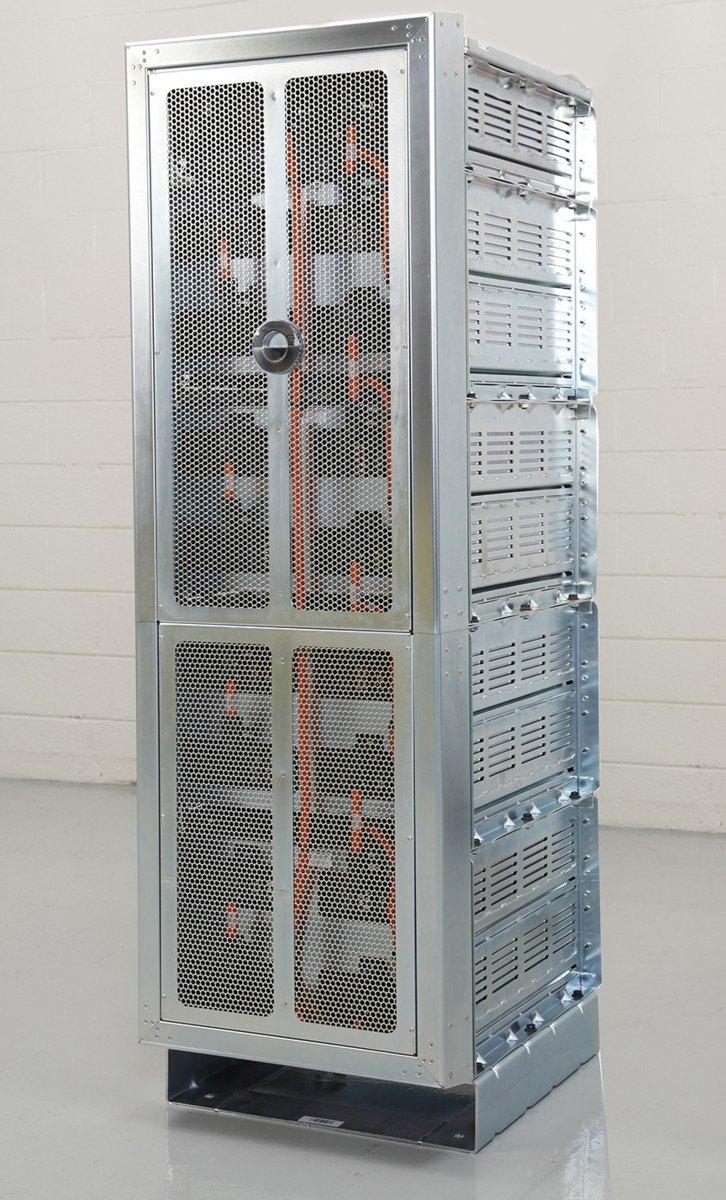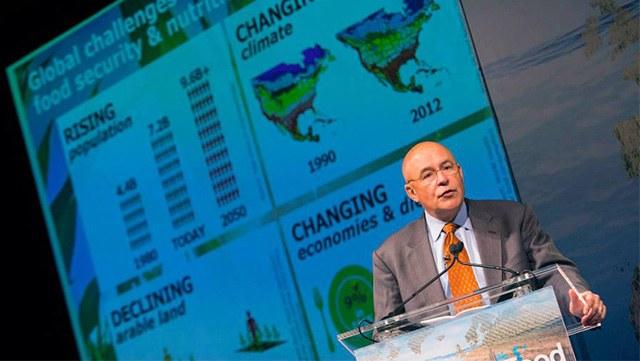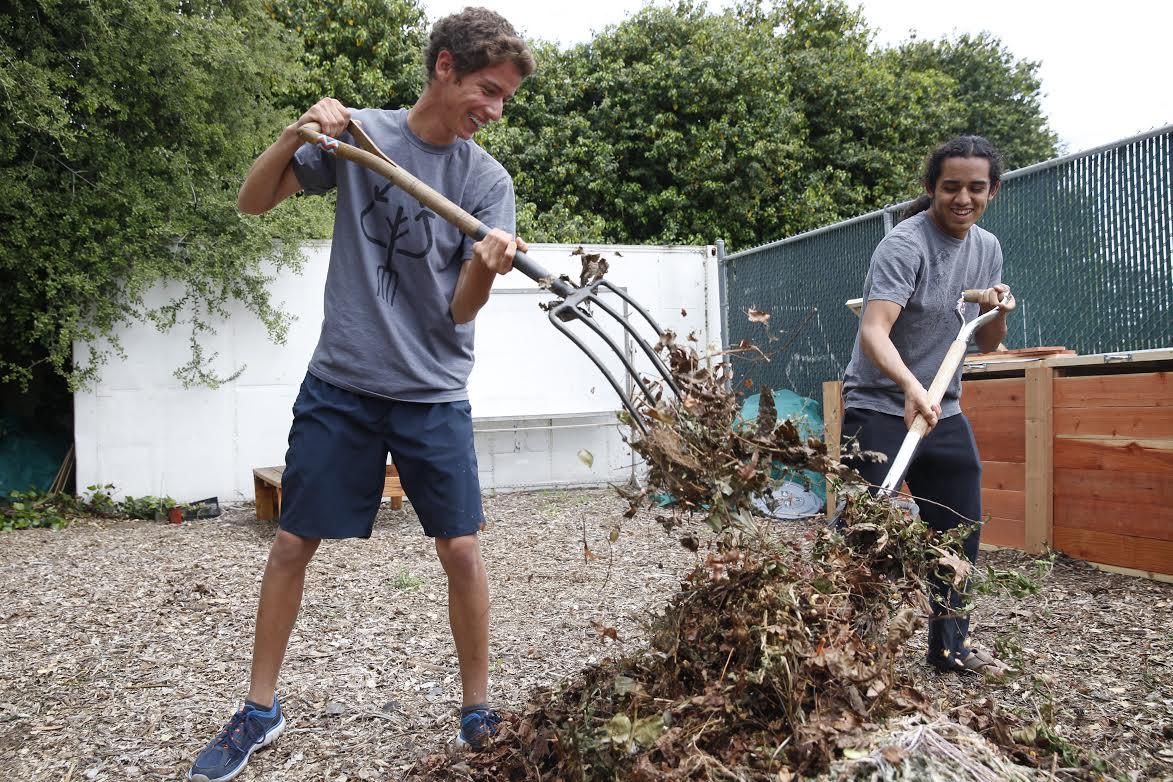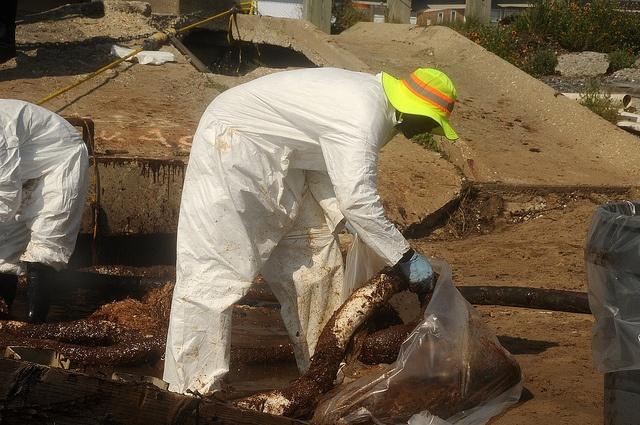Report: Insurance Companies Still Unprepared for Climate Change Risks


For an industry that is built upon gauging and managing risks, one would think the insurance industry would be more prepared to deal with climate change’s potential effects. But the most recent annual report by Ceres shows an overall lack of preparedness in confronting climate-related risks and addressing potential opportunities. Similar to last year’s report, Ceres found some leadership amongst 300-plus U.S. insurance companies it surveyed, but still finds a lack of innovation and long term planning.
The survey found that nine insurers, or three percent of the companies that responded to the survey, earned what Ceres described as a “leading” rating. Property and casualty insurers tend to have a greater understanding about how climate change could potentially affect their business; life and health insurers lag behind. And only about 10 percent of the surveyed insurance companies have publicly disclosed risk management statements that include climate change as a significant long term risk to their businesses. The larger companies pay more attention to climate change than smaller insurers, though exceptions, such as the Catlin Group, exist.
So who are some of the leaders?
Among the nine companies that Ceres said stands tall among insurers is Allianz. The company says it is adopting internal policies and processes to help the company develop its long-term climate change agenda. Allianz has also publicly supported the growth of a more low-carbon economy. Finally, one of its American divisions, Fireman’s Fund, is one example of how the company underwrites “green insurance” policies such as for environmentally friendly construction. Across the board, from stakeholder engagement to internal greenhouse gas reporting, Allianz consistently scored highly in the Ceres survey.
Another leading global insurer taking climate change seriously in Ceres’ eyes is Zurich Insurance Group. The company has publicly committed to investing up to US$2 billion in “green bonds,” which will fund a bevy of programs from energy efficiency in Mexico to clean energy projects in developing nations. Zurich is also an example of incorporating climate-related litigation into its strategy. This year it filed a class action lawsuit against dozens of municipal governments in the Chicago region, alleging they had not adequately prepared sewers and storm drains for flooding that occurred during spring 2014. The lawsuit was withdrawn, but this and similar episodes, insists Ceres, is one tactic by which insurance companies can protect their assets and customers—and hold companies accountable for what the United Nations Environmental Program (UNEP) describes as US$1.5 trillion in environmental damages worldwide.
Ceres’ final recommendations apply for any industry, but considering how another Hurricane Sandy-sized disaster can take a huge chunk out of any insurer’s assets, there is still much room for improvement within this sector. Ceres’ urges insurers to take the following steps:
- Establish climate risk oversight teams or committees with the companies’ boards and c-suites.
- Publicly issue a comprehensive policy on climate risk, especially so stakeholders know the company understands climate-related risks.
- Integrate climate risks within a company’s enterprise risk management framework.
- Develop a broad understanding about climate change’s impacts, both risks and opportunities.
- Disclose climate change risks to regulators, the way companies in other sectors have done with increasing frequency the past several years.
The full report from Ceres can be viewed here.
After a year in the Middle East and Latin America, Leon Kaye is based in California again. Follow him on Instagram and Twitter. Other thoughts of his are on his site, greengopost.com.
Image credit: Acva
CODA Automotive Back From Bankruptcy With Energy Storage Solution


Energy storage has become an exciting area, both as a new business and as an enabler for the continued rapid growth of renewable energy generation. While it’s true that Amory Lovins has claimed that it is possible for renewables to continue to grow without a massive investment in storage, he acknowledges that it would be helpful. This was the path chosen by the California’s Public Utility Commission when they decided last year to issue a set of goals intended to jumpstart the storage market. This led two of Elon Musk’s enterprises, SolarCity and Tesla to join forces to produce commercial energy storage systems, using refrigerator-sized batteries produced by Tesla Motors. Sales will be driven by the ability to reduce demand charges, via the operating software called DemandLogic. The program will be piloted in California, Connecticut and Massachusetts, markets with particularly high demand charges.
Another player has now entered the market, one that also has some history in the EV market.
CODA Energy was formerly known as CODA Automotive. The company, which had spent four years trying to enter the EV market, filed for bankruptcy last spring after selling approximately 100 cars. Now they are back trying to leverage their battery technology in the energy storage market. The product is a 40 kWh commercial-industrial storage system called CORE. Do they have a compelling value proposition? I spoke with John Bryan vice president, sales and marketing at Coda Energy to find out.
Triple Pundit: Can you give me a little background on Coda Energy?
John Bryan: The company was founded in 2001 by Peter Nortman as Energy CS, which did some preliminary development on the first plug-in Toyota Prius hybrid, though they also had a background in grid storage. That company was acquired by Coda Automotive, which also made batteries for hybrid-electric trains. Now, after Coda Automotive’s demise, the company was acquired by the Fortress Investment Group, which primarily owns buildings. They see energy storage as a way of reducing their operating cost. They say that every dollar saved in operating cost increases the value of the building tenfold.
3p: So now you are making batteries for buildings.
JB: That’s right. We came out in February with a commercial-industrial size battery. It’s now UL-certified, and we have been deploying ever since. We now have them operating in six states.
3p: What do you consider your most exciting or important application?
JB: It justifies itself with peak shaving, thus reducing demand charges, but it can also keep critical services running in the event of an outage. It can keep the elevators going, it can keep telecommunications operating. These systems are all turnkey financed, mostly on an internal basis, but we also expect to announce additional third-party financing options shortly.
3p: Will there be other development groups like Fortress, investing in their own buildings?
JB: In some cases yes, but some will also be looking outward to finance projects in other people’s buildings as well.
3p: So what makes your product offering unique?
JB: Our product is built to scale. There are very few moving parts and they are small enough that they can be placed under a stairs or in an elevator room. This turns out to be economical from a siting perspective. At the same time, the units are modular and can operate in parallel or in pairs within a facility. We received UL certification directly from UL (not a third party). We are also the first company to receive ISO certification for our system. We have what we call a multi-tower power controller, which offers a lot of flexibility in configuring the system.
3p: So at 40 kWh, your product is too big for home use.
JB: That’s correct. We’re focusing on the industrial-commercial market because that’s where the economics make sense. It’s our ability to help reduce demand charges, which typically don’t exist in the residential market, that makes our offering attractive today.
3P: What else do you feel it’s important for readers to know?
JB: With today’s technology, there is no need for the kind of impact that an event like Hurricane Sandy had on the power grid. We have equipment today that can detect an interruption in the grid and disconnect itself within four milliseconds. That’s fast enough to avoid the kind of collateral damage that we saw with Sandy.
3P: How do you differentiate yourself from Tesla’s partnership with SolarCity?
JB: They are vertically integrated down to the point of sale, making their own battery cells. We see these things as commodities. We produce energy storage systems that integrate purchased components. We add value in both the architecture and the control system. We are also uniquely positioned relative to commercial real estate. SolarCity is combining rooftop solar systems along with storage. That is not something we’re doing at the present time, though that could change in the future.
Coda Energy just announced a new installation of their CORE energy storage system at the Sunset Marquis in West Hollywood, California which is also the home of Nightbird Recording Studio.
Images courtesy of Coda Energy
RP Siegel, PE, is an author, inventor and consultant. He has written for numerous publications ranging from Huffington Post to Mechanical Engineering. He and Roger Saillant co-wrote the successful eco-thriller Vapor Trails. RP, who is a regular contributor to Triple Pundit and Justmeans, sees it as his mission to help articulate and clarify the problems and challenges confronting our planet at this time, as well as the steadily emerging list of proposed solutions. His uniquely combined engineering and humanities background help to bring both global perspective and analytical detail to bear on the questions at hand.
Follow RP Siegel on Twitter.
Five Data Tools Used to Improve Water and Food Security


By Molly Nance
As the world population soars toward 9 billion people, the demand for food is expected to more than double. Lack of water is a critical constraint to increasing food production, particularly as climate change makes water even scarcer.
Big Data is helping to meet that challenge. Experts from around the world gathered in Seattle this week at the Water for Food Global Conference to discuss ways to harness this data revolution in agriculture. Hosted by the Robert B. Daugherty Water for Food Institute at the University of Nebraska in association with the Bill & Melinda Gates Foundation, the conference focused on mobilizing Big Data to improve global water and food security.
Our speakers discussed five data tools for promoting water and food security:
- Global Yield Gap and Water Productivity Atlas: Are we on track to feed 9 billion people by 2050? “No!” said University of Nebraska-Lincoln agronomist Ken Cassman, a DWFI fellow. But we can get back on track. Freely available data provided by the public sector is key. He described an open-data effort he’s leading to identify existing farmland with the capacity to produce much higher, stable yields. The Global Yield Gap and Water Productivity Atlas is a major global collaboration in which researchers are gathering and analyzing satellite, atmospheric, soil and historic data to identify farmland where significant gaps exist between actual and potential yields for different crops.The mapping tools and models will help make global food security predictions and, even more importantly, help individual countries identify yield potential to improve policies, increase food production, conserve water and better strategize resource allocations. Increasing yields on existing farmland is necessary to help ensure natural areas aren’t sacrificed to agricultural production in the coming decades, Cassman said.
- Biotechnology: Robert T. Fraley, of Monsanto Corp., was also optimistic about meeting future food needs. Advances in plant breeding, biotechnology and agronomic practices are transforming agriculture, particularly helping to strengthen crop resiliency to drought and pests. Data science is the engine driving advances in biotechnology, he said.
- Greenhouses: How is it possible to produce food without consuming water? Pasquale Steduto, of the UN’s Food and Agriculture Organization, described an FAO project to develop the next generation in greenhouse farming. This sustainable agricultural solution achieves 90 percent reductions in water consumption compared to open farming by recycling water normally lost to plant transpiration and evaporation.They’re not for everyone, he said. But for arid countries that rely heavily on importing food, greenhouses can increase food security and water conservation, as well as reduce the vulnerability to food crises. The FAO is currently working on a pilot project in the United Arab Emirates.
- Water meters: Globally, agriculture consumes 70 percent of all freshwater withdrawals, primarily for irrigation. In many water scarce areas, water is pumped from aquifers at unsustainable levels. Data regarding aquifer conditions, groundwater withdrawals and other metrics are critical for water managers to prevent catastrophic depletions.Speakers from regions as diverse as Nebraska and Oman described their experiences with water metering. Though water metering to potentially regulate use is sometimes unpopular, it’s the only way to have a fair and transparent accounting of water use and to ensure that quotas are adhered to, said Wolfgang Kinzelbach, of the Institute of Environmental Engineering and Swiss Federal institute of Technology in Zürich.
- Global Burden of Disease: A panel of public health and child development experts enumerated the ways in which health, food production and water are linked. Emmanuela Gadidou, of the University of Washington, said water influences health through food production and diarrheal diseases. She described the Global Burden of Disease, a data-driven effort to provide detailed health information that countries and others can use to improve health conditions and the performance of their health systems.
To view more photos, visit the Water for Food Facebook page.
Video from the conference is available on the Water for Food Youtube page.
Molly Nance is director of communication and public relations at the Robert B. Daugherty Water for Food Institute at the University of Nebraska, a research, education and policy analysis institute created to address the global challenge of achieving food security with less pressure on water resources.
[Image credit: Craig Chandler / University of Nebraska-Lincoln]
Incorporating 'Green' Into Your Business Practices


By Jona Jone
Why are more and more companies going green? Most businesses have this response: It is simply the right thing to do.
Corporate Social Responsibility has evolved through the years. Much more than doing charity work, most companies are now implementing green measures because they just have to --- it improves corporate image, shows they care, and it is what customers demand. A survey by Grant Thornton, a consultancy firm composed of 2,500 companies, found a nobler reason --- companies believe that it is their responsibility to do so. Among the eco-work that companies are doing are: improve energy efficiency (65 percent), making products and services more sustainable (39 percent), and calculate their carbon footprint (31 percent). Another development is the increase in companies reporting on sustainability.
The reasons for going green are not a one-way thing. Companies are not adapting sustainability practices just because they are concerned about the environment but because it benefits them too, and in a great way.
So what’s in it for these big firms? How does a company start incorporating sustainability measures?
Objective: Be Sustainable
If a company were to be sustainable, what should it watch out for? What should be its objectives? According to the Environmental Protection Agency, a sustainable company should be able to incorporate “green thinking” into the company culture. This could be as simple as requiring employees to bring personal mugs and tumblers instead of maintaining a supply of plastic cups. Green businesses should also learn to eliminate inefficiencies, think long-term, consider impact to the environment, evolve and adapt to the changing world, and seek continual improvement.
Objective: Engage Your Employees
Define your green vision and plan your approach to achieve this. Employees are critical for implementing these plans that is why it is important that they are involved and know the direction you are taking. Pulling off green sustainability in business will require a cultural shift for your company and it is only the employees who can make changes happen.
Encourage employee participation and ask what they think. Consider creating a green team, provide incentives, and “walk the talk” as a manager.
Objective: Save Energy, Save Money
When these objectives are realized, businesses tend to save more money. In the Grant Thornton survey, 67 percent of firms said it is their primary reason for achieving sustainability through green measures. The efforts prove to be worth it.
In a related study, Buck Consultants surveyed 120 businesses and found that 69 percent have green programs in place. Among these companies, 78 percent reported savings in electricity cost, 68 percent in paper and heating/cooling, and 60 percent reported savings in water costs. How is this possible?
The EPA estimates that office buildings waste up to one-third of the energy they consume. Start with easy solutions to address this like replacing office bulbs. CFL and LED bulbs are more expensive than regular incandescent bulbs. A cost comparison shows using 25 CFL or LED bulbs over 50,000 hours can save up to $6,600 given the cost of electricity.
Heating and cooling systems also eat up energy consumption. This could be resolved by keeping unused spaces separate and reducing the amount of conditioned air that they receive. Make sure that thermostats are programmed and turned on less frequently during non-office hours.
Investing in energy-efficient appliances and products will also slash expenses. However, remember that the easiest and biggest savings come from a behavior change in a building’s occupants like turning off the lights when not in use. Using solar energy can also be a long-term solution.
Objective: Go Digital, Save Paper
The Natural Resources Defense Council found that a typical office disposes of about 350 pounds of waste paper per employee, per year. It is no wonder that the most common green initiative of companies is 97 percent paper reduction, according to Buck’s study.
Reduce paper waste and save trees by going digital. Require employees to keep files in digital form, communicate through email, distribute documents electronically, print on both sides of the paper, think before printing, recycle paper, and use paper with a high percentage of post-consumer waste (PCW).
Objective: Always Recycle
Recycling is at the core of sustainability. Our natural resources will dry up eventually at the rate of our consumption and it is by recycling and reuse that we can save whatever that’s left.
Implement a recycling program and cut down your trash cost and the volume of waste that you send to landfills. Minimize food waste with a composting system. Keep a recycling box at each desk to collect used paper. Purchase products and supplies that can be reused. Look for environmentally-friendly disposal options for electronic waste. Donate unwanted equipment to reduce office waste and even get a tax deduction.
Objective: Green Branding
Doing these simple yet rewarding steps do not only save money and make work more efficient; it also enhances corporate brand image. A survey by GlobeScan and SustainAbility shows that almost nine in ten or 88 percent of experts believe that improving sustainability performance makes a stronger brand. This shows that sustainability is now a valid competitive business issue and branding around green efforts shows just how conscientious corporate leadership is.
What’s Next?
Set goals and go for long-term objectives. Prioritize the goals that will help achieve your vision, make the most impact in the environment, and ones that make most sense for your business. Consider cost and benefits.
Progress in sustainability should be measured regularly to check whether strategies are working and what needs to be improved. Develop strategies to update your goals because sustainability is an on-going commitment to the environment and the future generation.
For businesses today, sustainability means so much more than just maintaining and growing operations and profits. Today, the concept has taken on a global effort to implement green initiatives and companies must be responsible enough to operate for the greater good. It is a good thing that carrying out sustainability efforts does not only help the environment and the future generation but also posts a significant return of investment for a company in terms of better branding and savings.
Image credits: 1) James Wang via Flickr 2) Stacie via Flickr
Jona Jone has been a mortgage originator in Philadelphia, PA. She is also a Business and Property Specialist. She has been writing articles about real estate investment, business, parenting and living.
Let’s Change the Way We Talk About Energy


By Aaron Hay, Senior Sustainability Advisor at Forum for the Future
Although Big Energy Saving Week is in full swing, you could be forgiven for missing the positive energy that this worthwhile and ambitious undertaking should represent. Over at The Guardian, a recent article highlighted that household spending on gas and electricity is up 137 percent since 2003-04 even though people are using 17 percent less energy. Elsewhere, The Independent weighed in just this Monday, with more discouraging news: a growing energy divide faced by lower-income households across the European Union.
Recent research we at Forum for the Future conducted with Behaviour Change and YouGov across the UK in October 2014 revealed a bleak state: 66 percent of people say there is nothing at all, or not very much they can do to reduce household energy bills, and at least two in five say their energy bills frustrate them. A clear lack of awareness on where people should go for help was uncovered.
It doesn’t have to be this way, households should be able to take control of their energy bills. Individuals and families can take steps to enjoy comfortable, healthy homes without the anxiety of ever-rising costs. That message isn’t cutting through the complex, negative and (no pun intended) heated rhetoric surrounding energy costs in the UK – which households hear almost daily.
The Big Energy Vision, which launches this week, is our unique endeavour to change the message. Forum for the Future and Behaviour Change have teamed up in a major partnership with sixteen household names and civil society groups, as diverse as B&Q, John Lewis, Argos, uSwitch, The National Trust and Citizens Advice Bureau, to communicate solutions in a way that makes it easy for people to use less, waste less and pay less for energy.
Behind the approach is a shared, positive language which our partners will deliver through their unique and far-reaching communication channels. At the heart of our strategy is encouragement for households to take action, united by the idea of ‘energy control’ over the things they can easily do. In short, our partners will present a clear, simple narrative in place of current complexity and confusion. This won’t just touch consumers – it’s also about reaching supporters, partner staff and volunteers with a powerful set of messages for talking about energy bills and solutions.
Over the coming months, you’ll see our shared, positive messaging deployed through our partners’ considerable public reach. But this isn’t a one-shot campaign; there is a host of activity planned for 2015 and beyond –our partners have provided long term support, knowing that the household energy conversation won’t just change overnight. It’ll take time for our message to resonate, but in five years’ time, we don’t want to look back and see more of the same: ever higher costs and further-discouraged households.
The Big Energy Vision is about something altogether different.
SXSW Eco Interview: Sara Batterby on Women in Venture Capital


This post is part of Triple Pundit’s ongoing coverage of the SXSW Eco conference. For the rest, please visit our SXSW Eco page here
Sara Batterby is a partner at Elemeno Ventures, an angel investing firm based in Silicon Valley. I had the opportunity to talk to Sara at SXSW Eco this month about why so few startups, especially in tech, are headed by women - as well as why this problem is relevant to a greater conversation about sustainability.
Learn more in the video below...
EC climate deal falls short on renewables targets


While the European Council has just agreed a new climate and energy deal that sets a binding domestic Greenhouse Gas Emissions (GHG) target of “at least” 40%, it has failed to agree ambitious targets for the share of energy from renewable sources and for energy efficiency.
The European Prince of Wales’s Corporate Leaders Group1, representing major EU businesses welcomed the agreement on the EU Energy and Climate package as a ‘major step forward’ but also warned on its shortcomings.
Philippe Joubert, Chair of The Prince of Wales’s Corporate Leaders Group said: “A united Europe committed to deliver at least 40% of reduction of greenhouse gas emissions can boost the momentum toward an agreement in international climate negotiations in Paris, speaking louder at the table and capitalising on its leadership.”
“However, with weak targets for renewables and energy efficiency and a low carbon price the EU must act urgently to unlock investment and spur the innovation needed to deliver its ambitions. In this respect we welcome the agreement to reform the EU emissions trading system and address the benefits of carbon capture and storage technology. ”
The group maintains that to deliver on the greenhouse gas emissions target the EU will now also need to put in place clear governance rules, legislation and standards to enhance the uptake of low carbon technologies and energy efficiency, especially in transport and buildings.
Banks beware: consumers rate ESG factors as high as service levels


Corporate performance on environmental, social, governance and ethical grounds can have a strong effect on how consumers feel about their bank or wealth manager. Indeed, a new Ipsos MORI survey for global responsible investment research firm EIRIS, finds that investment in companies that perform poorly on responsible or ethical finance concerns can be almost as strong a motivator in choosing to switch financial provider as poor customer service.
Among the 1,837 of those surveyed who have ever personally bought or taken out a financial product or service around a half (51%) are likely to consider switching from their main financial provider if they have reason to believe their financial activities (e.g. lending, insuring) contribute to harmful social activities, such as human rights abuses, child labour or forced labour.
Similarly, if these same consumers have reason to believe their main financial provider has faced potential fines for activities that breached financial regulations (such as money laundering regulations, mis-selling products or manipulation of interest rates), 47% are likely to consider switching, against just 13% who are unlikely to consider doing so.
These concerns are almost as strong switch factors as another main financial provider offering better rates, fees or conditions for a similar product or account (55%) or dissatisfaction with the customer service provided (62%).
"We believe the findings from this year's survey show that corporate performance on environmental, social, governance and ethical grounds can have a strong effect on how consumers feel about their bank or wealth manager. Leading financial product providers need to continue to develop responsible investment and lending policies, and to develop appropriate products for this growing market. This will enable providers to manage risks and make the most of opportunities from the links between reputation, responsible or ethical concerns and consumer attitudes," commented Stephen Hine, head of responsible investment development, EIRIS.
The full findings of the survey are available here.
Picture credit: © Swanomurphy | Dreamstime.com - Business Ethics Word Cloud Concept Background Photo
BP Op-Ed: Gulf Impacts Not So Bad!


BP is in hot water for an "op/ed" it published on Politico from senior vice president of U.S. communications and external affairs, Geoff Morrell.
Unsurprisingly, his position is that the long term impacts of the 2010 Deepwater Horizon oil spill weren't so bad, and the company's $27B dollars in cleanup were sufficient to offset any long term impacts.
The LA Times does a great job outlining all the impacts Morrell missed:
The answer, if you study the findings of experts, is that the spill has had massive impacts. These include immediate effects on sea fowl, marine mammals, and coral; and long-term effects on dolphins, sea turtles, fish and wildlife populations, and the gulf food web. Moreover, many effects are still imponderable at this time, because no one has studied an oil spill of this magnitude in a unique ecosystem such as the gulf. Assessing the damage may take decades, covering generations of animals.
As for why Politico would publish such a thing? Internet sleuths are blaming that on the fact that BP has been a frequent advertiser on Politico's Playbook, a daily briefing on DC's big stories of the day.
The op-ed was not marked as sponsored content, but one wonders if it was published thanks to a health dose of quid pro quo.
Not one to shrink down from a good old fashioned brouhaha, BP has responded to the kerfuffle by issuing a statement. Here it is in its entirety:
This is an opinion piece submitted by BP to an influential newspaper to counter several op-eds about the Gulf that previously were published in this and other media outlets. It’s no different than any other op-ed by any other company in any other publication.
So juicy. A company we love to hate gets (free) native advertising to tout itself.
I'd be remiss in calling out another publication for quid pro quo if I didn't mention our own stance on op-eds and sponsored content.
The issue of editorial independence is front of mind for me, as TriplePundit keeps the lights on these days thanks in part to generous sponsors who underwrite many of our series. Of course, our editorial is completely independent and these series are clearly labelled. Thanks to the support of sponsors, we're able to improve the quality of our journalism because we have more money in the bank to give writers. You can read our editorial policy on sponsored content here.
Thus far, we've been lucky to have sponsors we believe are true leaders in the sustainable business space. They are only interested in working with TriplePundit because they recognize and value our editorial independence and coverage of sustainable business. We are choosy about who we accept as sponsors because we realize that if we get loosey goosey with who we work with, that will hurt our brand.
Does this latest splish splash hurt Politico? Well, it's certainly been good for their traffic numbers. They've already chosen to work with BP as sponsors, so they must not think they're a totally bad company. BP wouldn't be a good fit to sponsor 3p, but we're a different organization. Maybe it's a net positive for Politico from their point of view.
At TriplePundit, we do our best to be completely transparent about these things and I know we might not always hit the mark. Please do call me out ([email protected]) if you think we've crossed the line.
In the mean time, go give BP some s**t for their bad behavior.
The 2014 Elections and the Road for Sustainable Business


By Zach Bernstein
Every year, the American Sustainable Business Council (ASBC) holds a summit to discuss and plan strategies for creating a greener, fairer economy that works for everyone. This year’s will be held after the midterm elections, at the White House and other locations in DC, and space is still available for those who would like to join the discussion.
A lot will depend on how sustainability-minded candidates do in November. Policies that support sustainable businesses can move the economy in a sustainable direction. And those policies depend on policy makers who understand the importance of sustainability – economically and socially as well as environmentally.
Unfortunately while many campaign ads tout a candidate’s economic bona fides, often the reality and the rhetoric don’t match up.
That’s why the ASBC Action Fund decided to take a look at a few races across the country to see how the solutions match up with the rhetoric. Some are big time races; others are less-well-known. Some are federal elections, and others are more local. All of them, however, will mean a lot for the future of our economy. They will determine who takes the reins at all the different levels of our government, and thus imply which policy paths we can take to move the economy forward.
Kentucky
Probably the closest-watched race of the cycle, this election will help determine whether Republicans win a Senate majority -- and if Sen. Mitch McConnell (R) will become the new Majority Leader. So it’s no surprise that Democrats are heavily backing challenger Alison Lundergan Grimes. On one issue, however, both are taking a position that’s bad for the economy.
Both McConnell and Grimes have announced their opposition to the Environmental Protection Agency’s (EPA) proposed rules on existing power plants, which would require coal plants to cut emissions by 30 percent by 2030. Both have argued the rules will be economically devastating. But in fact, the rules are a necessary step to fight back against climate change, which poses challenges like infrastructure damage, higher energy and health costs, and coastal flooding. Small businesses agree something has to be done -- unfortunately, these candidates are not listening.
Michigan
The ASBC Action Fund ran an ad earlier this year thanking Rep. Gary Peters (D) for supporting the automotive bailout in 2009. Now, Peters is running for the Senate seat being vacated by Carl Levin (D), and his opponent is Terri Lynn Land (R), who previously served as Michigan’s Secretary of State from 2003 to 2011.
Peters’ campaign website also details his support for clean air and water, promotion of clean energy and hybrid vehicles, and expanding access to capital for small businesses. Meanwhile, Land’s website explains that she wishes the 2014 Farm Bill, which she would have supported, had offered more support for family farms. She also backs changes to the gas tax in order to help the state pay for more infrastructure repairs.
However, Land states that she is in favor of the construction of the Keystone XL pipeline, which would transport dirty crude oil and bitumen from Canada and exacerbate climate change -- bad news for the economy and the planet. Meanwhile, there’s little independent evidence that it would have any meaningful impact on job growth.
New Hampshire
There’s a great deal of difference between the candidates in this race -- Senator Jeanne Shaheen (D) and challenger Scott Brown (R). Of particular note is a bipartisan energy efficiency bill, known colloquially as “Shaheen-Portman,” which failed earlier this year because of debates over unrelated issues, despite support from groups including ASBC, the U.S. Chamber of Commerce and Natural Resources Defense Council. According to some reports, Brown helped block the bill in the Senate.
There are other differences. Shaheen supports the EPA’s proposed carbon rules, while Brown released a white paper saying the rules would “result in job losses for energy workers and higher utility costs for homeowners.” His energy plan includes more oil and gas development on federal lands and the completion of the Keystone XL pipeline.
Colorado 6th Congressional District
It’s rated as a toss-up by the Cook Political Report. It “stands to be the state’s — and potentially the nation’s — toughest House battle of 2014,” wrote Politico last year. But while there are differences between Democrat Andrew Romanoff and Republican incumbent Mike Coffman, what’s more interesting is where they don’t discuss their differences.
Romanoff’s website touts support for a number of environmental initiatives, including protections for air and water, support for renewable energy, and energy efficiency. Coffman’s website? Not a word - either on environmental protection or the jobs that would result from investments in clean energy.
Virginia 10th Congressional District
With Rep. Frank Wolf (R) retiring, this race is also widely considered a tossup. Republican Barbara Comstock, a state delegate, is facing off against Democrat John Foust, a Fairfax County supervisor.
Neither side offers many specific policy proposals, but there are some clear differences. For example, Comstock’s website explains that she will work to repeal and replace the Affordable Care Act, though does not offer many specifics on what the replacement would be; Foust’s website says he supports the law, though he feels it was “less than perfect.” Comstock also supports offshore drilling for oil and gas, which is controversial at best; Foust’s website does not directly address the issue.
Ballot Initiatives
Even Americans who aren’t seeing a big race have a reason to head to the polls. Spending on ballot initiatives is expected to top $1 billion this year. Most states will have at least one on the ballot: Oregon and Colorado will be voting on GMO labeling, Massachusetts will consider a paid sick leave initiative, and five states will vote on minimum wage increases.
With congressional action on these issues stalled in recent years, this represents an opportunity for voters to push these policies forward and show Congress how out of step it is. Especially on issues like the minimum wage, there’s strong business support.
Elections have consequences. As business leaders -- and voters -- it’s crucial Americans make sure this one sends the message that it’s time to build a sustainable economy.
Zach Bernstein is a Research Associate with the American Sustainable Council Action Fund.